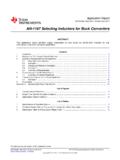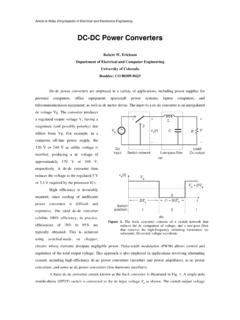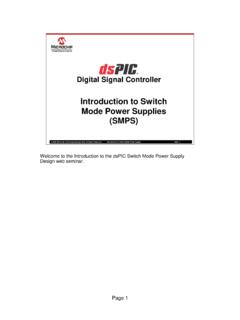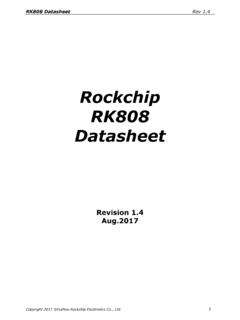Transcription of Second-Stage LC Filter Design - Ridley Engineering
1 Second-Stage LC Filter Designby Dr. Ray RidleyPower supply output voltages are dropping with eachnew generation of Integrated Circuits (ICs).Anticipated current level reductions have not materi-alized, and the problem of switching power supply noise ispervasive. Reducing noise with a conventional single-stagefilter seldom works. The inductor is already large, and drop-ping the noise an order of magnitude just isn t this reason, many designers add a second noise Filter atthe output of their power supply. The Filter typically consistsof an additional small inductance, and a small, high-qualitycapacitor. This seemingly intuitive approach can often leadto an unstable system.
2 The mistake is in designing with largecomponents followed by small a single-stage Filter is straightforward. The induc-tor is selected to give about 20% current ripple, and thecapacitor is chosen with sufficiently low ESR to meet theoutput ripple requirements. The output holdup and step-loadrequirements also impact the choice of resonance of a single-stage Filter is typically not a criti-cal concern. It is inside the feedback loop bandwidth (eithercurrent-mode or voltage-mode control) and its peaking andresonance effects are eliminated by the feedback. Figure 1shows a typical single-stage Filter designed for a point-of-Switching PowerCell 200 mH5 V20 A2500 (ms)Switching PowerCell 200 mH5 V20 A2500 mH10 mOhm250 (ms)Fig.
3 1: Point-of-Load Buck converter with Single-Stage FilterFig. 1a: Output Voltage Ripple of the Circuit of Fig. 1 Fig. 2: Point-of-Load Buck converter with Two-Stage FilterFig. 2a: Output Voltage Ripple of the Circuit of Fig. 2 DESIGNER S SERIESS witching Power Magazine July 20008 First InductorFirst CapacitorSecond InductorOutput Capacitorload converter , and Figure 1ashows the output voltage rip-ple with this 2shows a two-stage Filter . This is used to reduce theripple without substantially increasing the volume of powercomponents needed. A two-stage Filter is far more effectivethan a single stage, because components can be smaller forthe same amount of attenuation.
4 In fact, with this Design ,adding only 10% more capacitance and inductance givesmore than 30 times reduction in output ripple, as shown inFigure 2a. Notice that the scale of Figure 2a is enlarged 3mV full scale, compared to 30 mV full scale for the ripple ofthe single-stage 3shows what happens to the Filter transfer functionwith two stages. It still has a low frequency resonance closeto the single stage resonance, and this will be controlled bythe feedback loop. The second Filter resonance for this exam-ple is at 22 kHz. You can see from the transfer functions thatthe additional attenuation is more than 28 dB at the switch-ing frequency. Furthermore, the additional phase delay (notshown here) is less than 15 degrees at 10 kHz, so stability isnot significantly second Filter resonance that you get with a two-stage fil-ter must be placed very carefully beyond the control loopcrossover to avoid stability problems, but at a low enoughfrequency to attenuate both the switching frequency rippleand the high frequency noise.
5 This presents a challenge tothe designer. Furthermore, the Design of the Filter must berobust and stable under worst case conditions of line, load,and any extra capacitance the user may add. Most two-stage filters are designed in as an afterthought. Theconverter is finished, but the noise is too high, and there isonly room and time to put some small components on theboard. This works when the converter is tested on the bench,but when placed in the application, load bypass capacitorscan significantly change the Filter characteristics, reducingthe second resonance to a frequency where it causes instabil-ity. To understand a better way to do it, let s look at theanalysis of the two-stage Filter the FilterIt is important to know how the components of the two-stagefilter interact.
6 Recognize that the inductors of the two-stagefilter are very different in size the first inductor is largest,in order to constrain the ripple currents in the power semi-conductors. Select it on this basis, as you would for a single-stage are two pairs of poles for this Filter . They determinethe location and characteristics of the resonant frequenciesshown in Figure 3. These poles are given by:There are two resonances a low frequency resonance, anda high frequency resonance. The firstresonant frequency is calculatedfrom the circuit of Figure 4. where Cpis the parallel combinationof 2001000 Frequency (kHz)Single-Stage FilterTwo-Stage FilterGain (dB)Fig.
7 3: Output Filter Transfer FunctionsDESIGNER S SERIESJuly 2000 Switching Power Magazine9In otherwords, we addthe capacitorvalues togeth-er to get thefirst resonanceformed withthe resonant frequency won t move much with capacitiveloading. There is usually sufficient capacitance in the Filter thatany load capacitance won t significantly change the with a 2:1 change, the Filter resonance would only moveby 40%, and stability will not be a Q of the first resonance is not very interesting. We llclose a control loop around it, and use the feedback to cancelthe Filter peaking effects. The second Filter frequency is given by the circuit of Figure Csis the seriescombination of capacitorsgiven by:this expression is dominated by thesmaller of the two capacitors.
8 Thiscreates an interesting Design choice. If the output capacitor, C2is smaller, the second resonanceis very sensitive to any capacitive loading by the fact, load capacitance can make the system the first capacitor, C1, is smaller, the second resonance isinsensitive to capacitive loading, and system stability can bemaintained with significant load capacitance. This is theproper way to Design two-stage most applications the second Filter resonance is placedbeyond the crossover frequency of the feedback loop. (We llexamine in a future issue of Switching Power Magazinewhether that can be changed for some converters an inter-esting possibility brought up recently by one of our readers.)
9 We must control this resonance very careful, by fixing theresonant frequency, and then by controlling the peaking withdamping elements. This is similar to input Filter Design . Wedon t directly damp the resonances with a control loop, sowe must damp them with resistive components. The Q of the second Filter is given by:For good Design , the Q of the second stage Filter should be oneor less. It is usually necessary to compromise the attenuation ofthe Filter to achieve this. Increasing the inductor resistance, R3,would allow us to damp the two-stage Filter without sacrificingattenuation, but this increases the dissipation of the Filter . Forthe Filter Design of Figure 2, the ESRs of all three reactive ele-ments contribute to the Filter this analysis, it s easy to Design the second Filter .
10 Thesmaller capacitor has to be carefully selected to carry the fullripple current from the inductor. In some power supplies, thisentails using a different type of capacitor. Even though it isten times smaller in capacitance for the example in this arti-cle, the ESR has to be a similar value to the output commercial applications, this often leads to film capaci-tors for the first stage, and electrolytic or tantalum capacitorson the ApplicationSince this Filter technique was first developed, many compa-nies have adopted it as the standard way to Design . This is thetechnique used by IBM in the Design of all load regulators fortheir mainframes described in this magazine.






